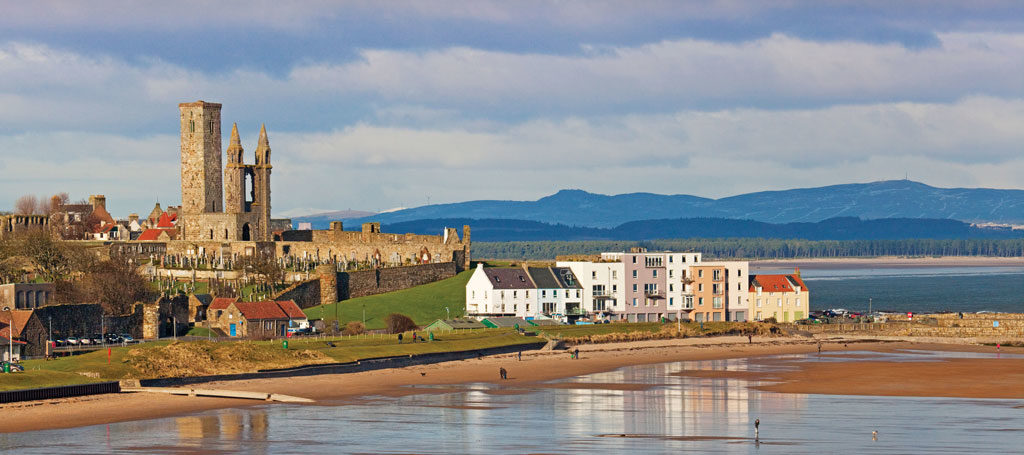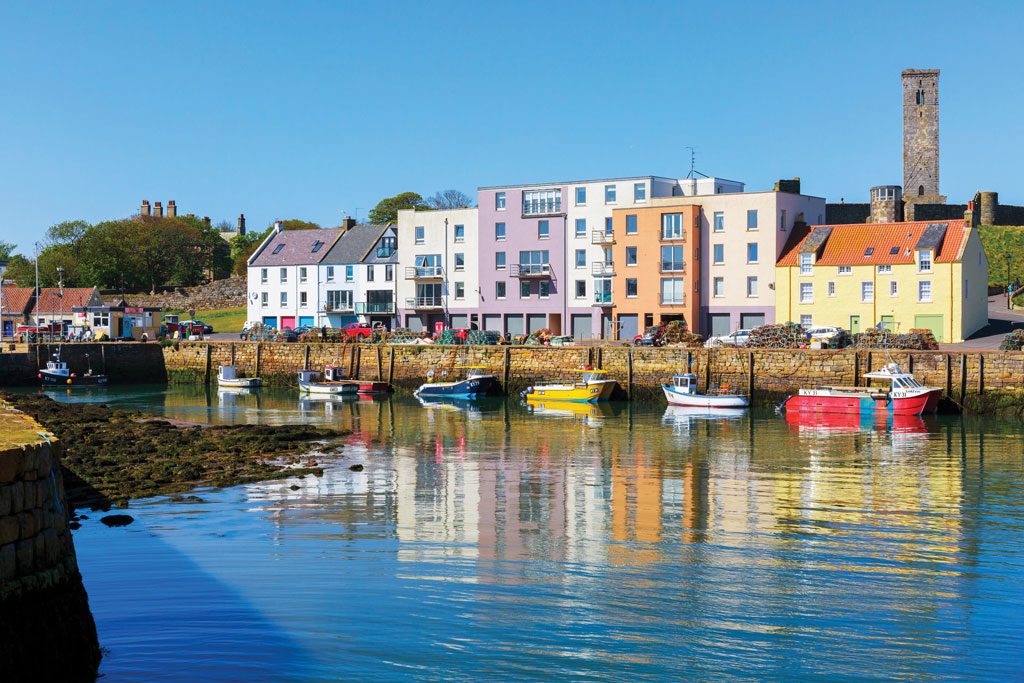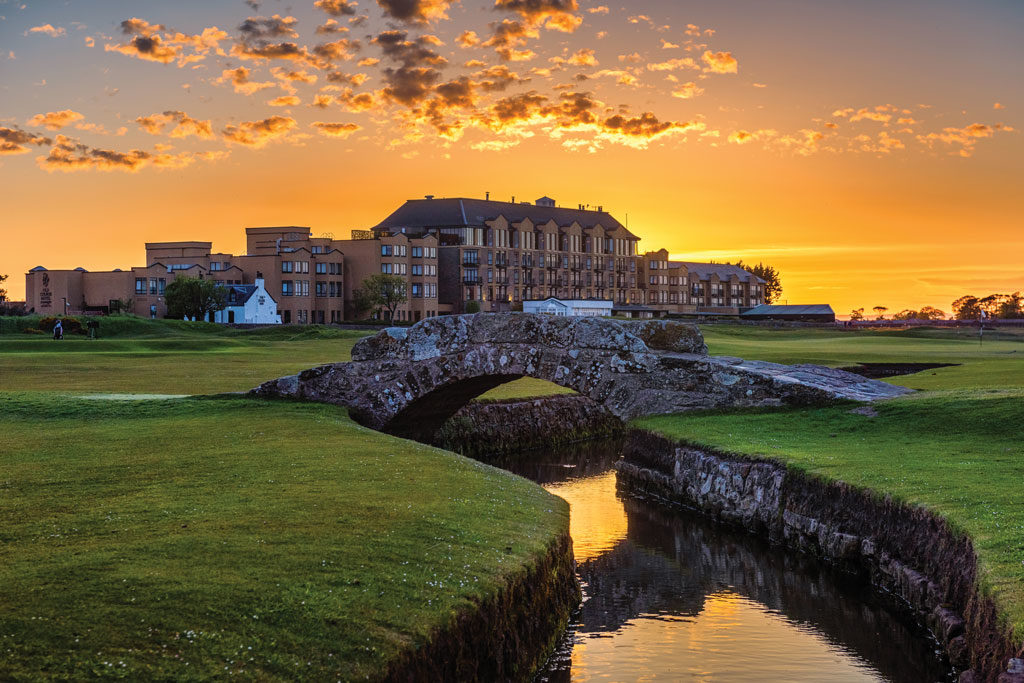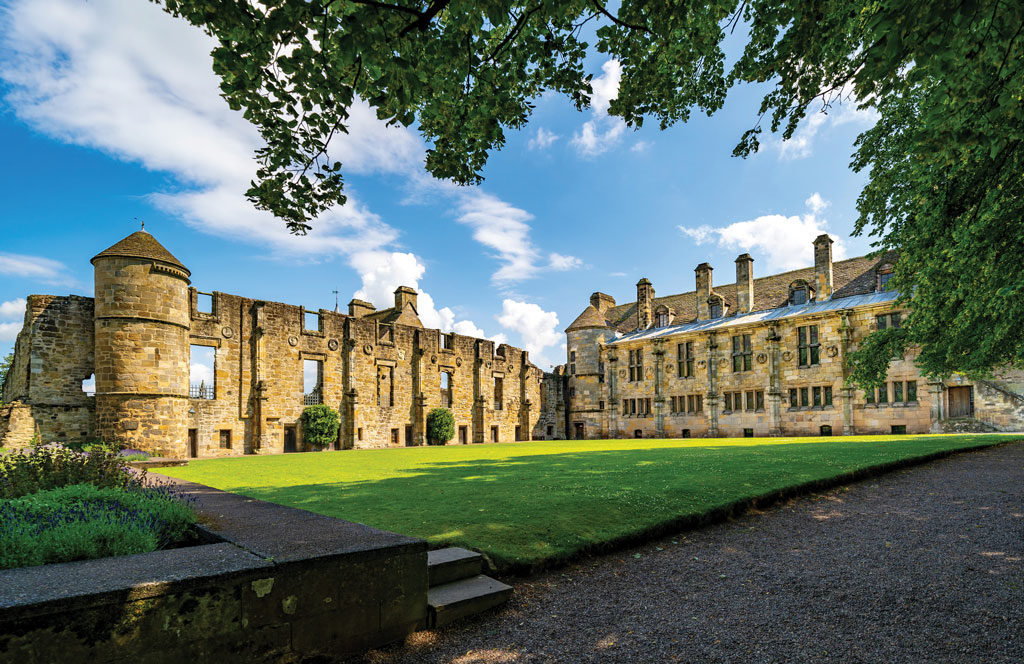We explore the well-polished jewel in Fife’s crown, St Andrews
MORE FROM SCOTLAND MAGAZINE
The picturesque seaside town of St Andrews is worthy of most Scottish itineraries, even if you have no interest in golf – though if you do, you’re in for a treat.
But to truly understand the origins of this historic and architecturally grand town, we must go back to the 4th century and the arrival on its shores of a Greek monk known as St Regulus.
According to Walter Bower’s Scotichronicon, compiled in the 15th century, St Regulus (anglicised to St Rule), was told by an angel around AD 357 to remove the bones of St Andrew, the brother of St Peter, from his sarcophogas in the city of Patras, and take them somewhere for safekeeping.
St Regulus was instructed to sail westwards out of the Mediterranean, around the coasts of Portugal and France, into the English Channel and then head north. The ship was wrecked on rocks
off the coast of Fife and the story goes that, having survived, St Regulus was commanded by God to build the foundations of a church to house the relics – three fingers, an arm bone, a kneecap, a tooth and part of a skull.
There are several apocryphal versions of this story but for the purpose of this narrative, it is suffice to say that the site chosen by St Regulus was that of the future great Roman Catholic St Andrews Cathedral, which was to become the epicentre of Christianity in Scotland. Around it sprang up the town, which is dedicated to the apostle who not long after was adopted as the Patron Saint of Scotland and for seven centuries or more it was an important place of pilgrimage.
The University of St Andrews was founded in 1412 by Bishop Henry Wardlaw and is the oldest seat of learning in Scotland and the third oldest in the United Kingdom and English-speaking world in general. The Bishop’s modernistic statue by the Kilmany-based sculptor David Annand, stands in St Mary’s Quadrangle on South Street.

Nowadays, St Andrews University is largely referred to as the place where the Duke of Cambridge met his future wife, the then Catherine Middleton, when they were both students in the town from 2001 to 2005. University life continues to dominate the town, but in a largely unobtrusive way, revealing itself with an explosion of colour during annual events such as the Mermaids’ Christmas and Graduation Balls, Raisin Week in November, the Rag Week Fashion Show – where the Duchess of Cambridge caught the eye of the Duke on the catwalk – and the May Dip, when students
are traditionally encouraged to plunge into the cold North Sea.
Another quaint custom is the annual Kate Kennedy Procession in mid-April where students dress up as characters from Scottish history and parade through the streets led by the St Andrew’s Pipe Band. Kate was the niece of Bishop Kennedy, Bishop Wardlaw’s successor, who in 1450 founded St Salvator’s College. His niece’s role is traditionally (and nowadays rather controversially) taken by a male student.
The ruins of 12th-century St Andrews Castle, which doubled as the Bishop’s Palace, and the nearby cathedral, dominate the town centre. Overlooking a small beach called Castle Sands, it is easy to imagine the castle walls coming under attack from the English in 1296 and being blasted from the sea by the French naval bombardment during the Scottish Reformation.

In 1546, Scottish Protestants were considered a threat to the Crown and that year the popular preacher George Wishart was imprisoned in the castle’s sea tower by Cardinal Beaton, who gave orders for him to be burnt at the stake.
Watching this unpleasant spectacle was George Wishart’s friend, 33-year-old John Knox who, two months later with Protestant leaders, gained entry to the castle disguised as a mason. Beaton was murdered and his body hung from a window.
Whether or not the future founder of the Presbyterian Church of Scotland was directly implicated in the murder of Beaton is still subject to debate, but when the castle eventually fell to a sea invasion from the French Navy, led by supporters of the Queen Regent Marie de Guise, Knox was captured and sent to Nantes as a galley slave until he was released 19 months later. Nowadays, St Andrews Castle, with its spooky Bottle Dungeon and underground mine, is a fascinating place that evokes a sense of what a medieval castle must have been like.
Until it was ransacked by the Protestant mob in 1559, St Andrews Cathedral had, for over half a century, been the headquarters of the Archdiocese of St Andrews and Bishops and Archbishops of St Andrews. Its elegant Gothic remains, the immensely high grey sandstone St Rule’s Tower (which once housed the saint’s relics and is haunted by a friendly monk); the East Tower, and the Nave, reveal the original building’s astonishing size – at 391ft long it is the largest church ever to have been built in Scotland.

Exploring the town’s medieval streets, its ports, pends and wynds, and the Old Fishing Quarter is an intriguing adventure for all. Outside the entrance to St Salvator’s Quandrangle are the letters PH, spelled into the cobbles, and legend has it that if a student should walk across them, they will fail their degree. Other plaques you may come across on your travels include one to ‘The Admirable’ James Crichton, an accomplished 16th-century polymath who studied here, while the strange marking on the Blue Stane behind railings on the corner of Market Street often provokes intrigue. Legend says it is the devil’s fingerprint, left on a stone that he threw at St Regulus. Listen out too for the curfew bell that traditionally chimes 100 times every evening – a throwback to when bells were rung to ensure townsfolk were safely within the city gates.
The Byre Theatre in Abbey Street was founded in 1933 by Charles Marford, an actor, and Alexander Paterson, a local journalist, and the current building was opened in 2001 by Sir Sean Connery. Despite a blip in its fortunes a few years ago, it has now been revived and has an exciting cultural programme of theatre and music.
St Andrew’s rich history can be further explored at the St Andrews Museum, a fine Victorian mansion in the grounds of Kinburn Park. Here there is a commemorative bust of General Wladyslaw Sikorski, the prime minister of Poland’s London-based government-in-exile during the Second World War. Sikorski died in a plane crash in 1943, but was responsible for St Andrews offering a home to exiled Poles, many of whom married locally and stayed behind when hostilities ended.

Of course, one of the biggest draws for visitors to St Andrews is golf. It earned its moniker ‘Home of Golf’ as it was here that the Royal & Ancient Golf Club of St Andrews was founded in 1754, which, until 2004, exercised supreme authority over the game worldwide (with the exception of the USA and Mexico). The Royal & Ancient has also served as a regular venue for The Open Championship, the oldest of golf’s four major international competitions.
The Old Course, with its landmark Swilcan Bridge at the 18th hole, and the
six other public courses – the Balgove, Eden, Jubilee, Strathtyrum, New and Castle Course – are considered to be among the finest in the world. Those who remember the inspirational 1981 film Chariots of Fire will recognise West Sands Beach, right by the Old Course, where the heroic Eric Liddell, a devout Scottish Christian, trains for the 1924 Olympics.
St Andrews remains picture perfect; the gemstone of Scotland’s east coast landscape. It is easily accessible by road and rail from Edinburgh to the south, and Perth and Dundee to the north, making it a popular destination for a few days or more.
READ MORE: Regional Focus: Argyll
If you’re heading to St Andrews from Edinburgh then the first major historic site over the Firth of Forth is the town of Dunfermline where, c.1068, Malcolm III (Canmore) was married to the pious
Austro- Hungarian Princess Margaret and in 1128, their youngest son David I erected a new and magnificent Benedictine Abbey.
Within the surrounds of the abbey are the tombs of seven Scottish kings and four Scottish queens who at one time or another occupied the adjacent, now ruined palace. Most prominent is that of the beatified Queen Margaret. While in the town, pop into the Andrew Carnegie Birthplace Museum, housed in the childhood home of Scottish-American industrialist and benefactor Andrew Carnegie who was born in Dunfermline in 1835.
This former royal hunting lodge was embellished by King James IV and then his son James V in the 16th century. It later provided a safe childhood retreat for James V’s daughter Mary, Queen of Scots and from here, the Stewart residents indulged their love of falconry and set off in pursuit of deer and wild boar. It is also claimed that the first games of real tennis were played here in the 15th century and the tennis court still stands. Filled with medieval treasures and centuries-old carvings, Falkland Palace is a fine example of Renaissance-style architecture and well worth a visit.
On the outskirts of Newburgh in northern Fife are the remains of Lindores Abbey, founded in the late 12th century by David, Earl of Huntingdon (brother of King William I) and today recognised as the spiritual home of Scotch whisky. The first written record of ‘aqua vitae’ dates from 1 June 1494 when Friar John Cor, a Tironensian monk domiciled at the Abbey, wrote about it. This confirms the longevity of Scotland’s national drink. Dismantled around 1584, the abbey has stood in ruin since. In tribute to its connection with the uisge beatha, the Lindores Abbey Distillery on the Lindores Abbey Farm was officially opened in 2017.
What to do:
No visit to Fife’s grandest town is complete without stopping off at this iconic golf course overlooking St Andrews’ West Sands Beach. View the famous Swilcan Bridge and Hell Bunker from the outside or book a round and imagine you are playing in the Open.
Where to stay:
Balmule House, Dunfermline
This 500-year-old Fife tower house, just a few miles outside Dunfermline, both looks and feels the part of an old country house done good, with freshened-up stonework, gorgeous grounds, a real fireplace in each room, iron bed steads and oodles of character.
Old Course Hotel, St Andrews
For five-star accommodation, views of the Old Course, plus an excellent spa, this grand dame of the hotel scene in St Andrews is hard to beat, though it does come at a price.
Where to eat:
The Seafood Ristorante, St Andrews
Known as the ‘glass box’ due to its contemporary-style building, this is a fail-safe choice if you’re looking for sensational seafood alongside well-prepared Italian and
British fusion food.
MORE FROM SCOTLAND MAGAZINE

SCOTLAND MAGAZINE
Published six times a year, every issue of Scotland showcases its stunning landscapes and natural beauty, and delves deep into Scottish history. From mysterious clans and famous Scots (both past and present), to the hidden histories of the country’s greatest castles and houses, Scotland‘s pages brim with the soul and secrets of the country.
Scotland magazine captures the spirit of this wild and wonderful nation, explores its history and heritage and recommends great places to visit, so you feel at home here, wherever you are in the world.